Cell Theory Activities for Middle School Science
The resources below will provide students a comprehensive understanding of cell theory. All of the following lessons are also included in the Kesler Science Membership.
The Cell Theory 5E Lesson includes materials for every "E" phase, including the Cell Theory Station Lab for Exploration and an interactive PowerPoint with digital INB templates for Explanation.
The lesson also includes introduction materials for Engagement, student-choice project ideas for Elaboration, and assessments for Evaluation.
After completing the Cell Theory 5E Lesson, students will be able to recognize that according to cell theory all organisms are composed of cells and cells carry on similar functions such as extracting energy from food to sustain life.
The Cell Theory Inquiry Lab is a hands-on activity that is differentiated for advanced, on-level, and modified middle school students.
Students will build a cell city and identify which parts of the city relate to the cell organelles.
The Cell Theory Inquiry Lab includes a brief reading passage, comprehension checks, hands-on activities, reflection questions, and a CER conclusion.
The Cell Theory Sub Plan is a complete lesson that takes students through a warm-up, reading passage, independent activity, extension activities, and an assessment.
The worksheets are designed to make your sub day a breeze for you, your students, and the substitute teacher. They are also perfect for distance learning.
Cell Theory Classroom Experiences
Create a powerful student experience to help solidify students' understanding about cell theory. The following experience is also included in the Kesler Science Membership.
Escape Rooms
The Cells Escape Room is an immersive experience for your students. It allows them to demonstrate their knowledge of cells and cell organelles in a fun and engaging format.
Students must use what they have learned to differentiate between structure and function in plant and animal cell organelles, including cell membrane, cell wall, nucleus cytoplasm, mitochondrion, chloroplast, and vacuole. They will also compare the functions of cell organelles to the functions of an organ system, recognize the components of the cell theory, and conduct an investigation to provide evidence that living things are made of cells; either one cell or many different numbers and types of cells. Students will develop and use a model to describe both the function of a cell as a whole and ways parts of cells contribute to the function. Lastly, they will use argument supported by evidence for how the body is a system of interacting subsystems composed of groups of cells to complete the escape room.
Year-Round Resources
These year-round activities will increase your students' understanding of many middle school science topics. All of these activities are also included in the Kesler Science Membership.
Visual Data & Graphing
You're not alone if your students struggle with understanding graphs, charts, and tables. It's a skill that takes an enormous amount of practice. This resource will help students build a strong foundation in analyzing data and creating their own data visualizations.
Bell Ringers and Warm-Ups
These middle school science bell ringers are an excellent way to engage your students as soon as they walk into your classroom. This comprehensive FULL YEAR resource includes everything you need to start off each science class with an interesting warm-up activity.
Review Board Games
Each game board has been carefully designed to keep students engaged. There are 10 different action spaces on each board and dozens of question cards. All of the actions are related to science concepts and keep the students motivated throughout the game.
Each game is ready to play. Simply print out the board and the cards and let the students enjoy reviewing nine different units.
Essential Questions and Standards
Below are the essential questions and standards associated with the lessons and activities included in the atoms unit. This topic is only one of more than 100 middle school science topics included in the Kesler Science Membership.
-
What is the cell theory?
-
What are similar functions of all cells?
-
MS LS1-1 - Conduct an investigation to provide evidence that living things are made of cells either one cell or many different numbers and types of cells
-
MS LS1-2 - Develop and use a model to describe the function of a cell as a whole and ways parts of cells contribute to the function
-
MS LS1-3 - Use argument supported by evidence for how the body is a system of interacting subsystems composed of groups of cells
-
TEKS Science 7.12 F - Recognize the components of cell theory
Kesler Science Membership
Imagine never having to search for another middle school science lesson again. The membership gives you access to ALL of the Kesler Science products in one place (Yes, including everything above).
Say goodbye to long hours of lesson prep.


